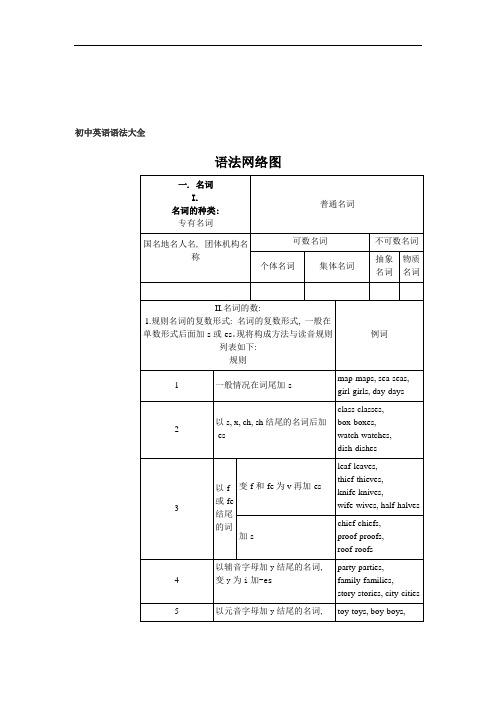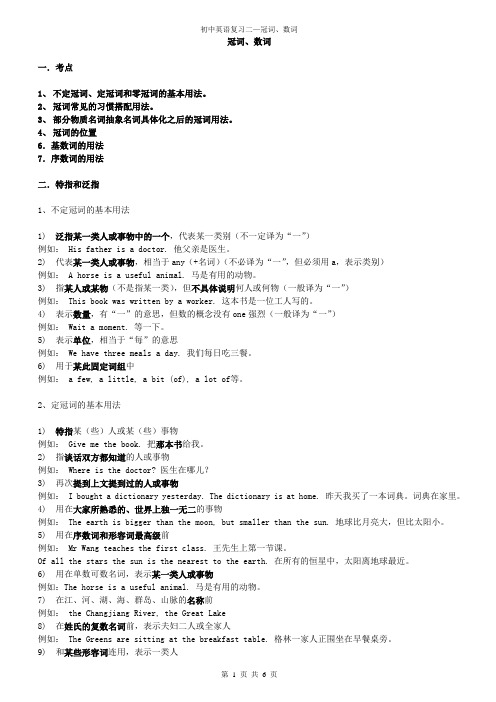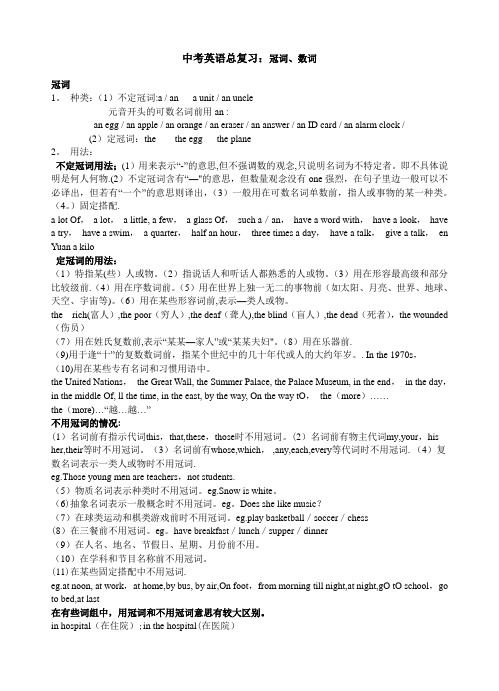初中英语语法之二冠词和数词(通用版)
- 格式:doc
- 大小:31.01 KB
- 文档页数:3

初中英语语法大全语法网络图十二。
倒装句十三。
虚拟语气十四。
重要句型1.It was not until midnight that he finished his task.2.Not until he came back from abroad was I able to see him again. 3.The harder you work, the greater progress you will make.4.He walked around the house, gun in hand.5.May you be in good health!6.Wish you a pleasant journey back home!7.The professor was a humorous man with big nose and deep-set eyes.8.What surprised me most was his imagination and patience.9.He lay on the grass, with his eyes looking at the sky and his hands under his head. 10.Sitting under the tree are Mr.Green and his first teacher.11.On the wall hang two pictures of famous scientists.12.Looking back upon those past years, he couldn’t help feeling very proud.13.No sooner(Hardly) had he arrived at the theatre than(when) the play started.14.Young as he is, he has learned advanced mathematics.15.How I regret the hours wasted in the woods and fields!16.There stands a beautiful vase in the corner of the room.17.Ten miles north of the town lies a paper factory.18.There goes the bell.19.Nowhere has the world ever seen such a bird as here.20.It is no use crying for help.21.If only I had been your student in the middle school!22.It is believed that such a thing will not happen again.23.Only when he explained did I realize the reason for this.24.“He works particularly hard.”“So he does, and so do you.”25.Not only Alice but also Jane and Mary are tired of having one examination after another.26.Such was Albert Einstein, a simple person of great achievements.十五。

学习初中英语中的常见冠词和数词常见冠词和数词是初中英语学习的基础知识之一。
掌握这些基本的语法规则,对于学习英语的进一步发展至关重要。
本文将详细介绍英语中的冠词和数词,包括其用法和注意事项。
一、冠词冠词是英语中重要的语法成分,用来确定名词的特定性或泛指性。
英语中的冠词分为不定冠词(a, an)和定冠词(the)。
1. 不定冠词不定冠词用于表示泛指或不确定的名词。
a 用于以辅音音素开头的名词前,an 用于以元音音素开头的名词前。
例如:- I have a book.(我有一本书。
)- She is an actress.(她是一位女演员。
)需要注意的是,不定冠词在表示职业、国籍、宗教、食物等方面具有限制性。
2. 定冠词定冠词用于表示特指或已知的名词。
the 是唯一的定冠词。
例如:- The book on the table is mine.(桌子上的那本书是我的。
)- The sun rises in the east.(太阳从东方升起。
)定冠词 the 还可用于表示某类事物的整体,或与特定名词连用以表达特殊含义。
二、数词数词用来表示数量或顺序,在英语中有基数词和序数词两种形式。
1. 基数词基数词用来表示数量或数量关系。
常见的基数词有one, two, three, 等等。
例如:- I have two cats.(我有两只猫。
)- There are four seasons in a year.(一年有四个季节。
)基数词还可以与名词连用,表示具体的数量。
2. 序数词序数词用来表示顺序或序列。
构成规则:基数词末尾加-th 或者直接按照序数词的拼写规则。
例如:- He is the first one to arrive.(他是第一个到达的。
)- Today is the seventh of June.(今天是六月七日。
)序数词还可以表示日期或某一事件发生的顺序。
三、常见用法和注意事项1. 冠词的用法- 用 a 或 an 表示单数可数名词的泛指。


冠词、数词一.考点1、不定冠词、定冠词和零冠词的基本用法。
2、冠词常见的习惯搭配用法。
3、部分物质名词抽象名词具体化之后的冠词用法。
4、冠词的位置6.基数词的用法7.序数词的用法二.特指和泛指1、不定冠词的基本用法1)泛指某一类人或事物中的一个,代表某一类别(不一定译为“一”)例如: His father is a doctor. 他父亲是医生。
2)代表某一类人或事物,相当于any(+名词)(不必译为“一”,但必须用a,表示类别)例如: A horse is a useful animal. 马是有用的动物。
3)指某人或某物(不是指某一类),但不具体说明何人或何物(一般译为“一”)例如: This book was written by a worker. 这本书是一位工人写的。
4)表示数量,有“一”的意思,但数的概念没有one强烈(一般译为“一”)例如: Wait a moment. 等一下。
5)表示单位,相当于“每”的意思例如: We have three meals a day. 我们每日吃三餐。
6)用于某此固定词组中例如: a few, a little, a bit (of), a lot of等。
2、定冠词的基本用法1)特指某(些)人或某(些)事物例如: Give me the book. 把那本书给我。
2)指谈话双方都知道的人或事物例如: Where is the doctor? 医生在哪儿?3)再次提到上文提到过的人或事物例如: I bought a dictionary yesterday. The dictionary is at home. 昨天我买了一本词典。
词典在家里。
4)用在大家所熟悉的、世界上独一无二的事物例如: The earth is bigger than the moon, but smaller than the sun. 地球比月亮大,但比太阳小。
5)用在序数词和形容词最高级前例如: Mr Wang teaches the first class. 王先生上第一节课。

二、冠词和数词冠词概述冠词是虚词,它不能独立存在,不能单独作句子成分,只能附在一个名词上说明这个名词。
冠词分为不定冠词____/______和定冠词_______还有一种是零冠词。
不定冠词一般表示泛指;定冠词一般表示特指。
1. 不定冠词a(an)的用法A. 不定冠词a(an)用于单数可数名词前。
除an用于元音音素前外,其余都用a;如:a girl,an English book B. 不定冠词用来表示类别,指某一类人或某一类事物中的一个(泛指)。
如:His father is a doctor.I work in a middle school in Beijing. C. 不定冠词用于单数可数名词前,可以表示其全类(泛指)。
如:An English teacher teaches the students how to learn EnglishD. 不定冠词用于一些固定词组中:A little, a few, a lot of , after a while, have a cold, in a hurry, have a break, .......定冠词the的用法:与指示代词this,that,these,those同源,有―这‖―那‖―这些‖―那些‖的意思,但较弱,可以和一个名词连用,来表示某个或某些特定的人或东西。
A..可以用在单数或复数名词之前,表示特指一类人事物。
B. 表示上文提到过的人或事物。
如:He bought a house, I have been to the house.C. 用于单数可数名词前,表示整体或类别。
如:熊猫是稀有动物:(三译)The panda is a rare(稀有) animal. 此句等于:A panda is a rare animal. = Pandas are rare animals.D. 用来表示世界上独一无二的事物。
如:the sun, the moon, the sky, the earth,E. 用于表示方位的名词前。

中考英语总复习:冠词、数词冠词1。
种类:(1)不定冠词:a / an a unit / an uncle元音开头的可数名词前用an :an egg / an apple / an orange / an eraser / an answer / an ID card / an alarm clock /(2)定冠词:the the egg the plane2。
用法:不定冠词用法;(1)用来表示“-”的意思,但不强调数的观念,只说明名词为不特定者。
即不具体说明是何人何物.(2)不定冠词含有“—"的意思,但数量观念没有one强烈,在句子里边一般可以不必译出,但若有“一个”的意思则译出,(3)一般用在可数名词单数前,指人或事物的某一种类。
(4。
)固定搭配.a lot Of,a lot,a little, a few,a glass Of,such a/an,have a word with,have a look,have a try,have a swim,a quarter,half an hour,three times a day,have a talk,give a talk,en Yuan a kilo定冠词的用法:(1)特指某(些)人或物。
(2)指说话人和听话人都熟悉的人或物。
(3)用在形容最高级和部分比较级前.(4)用在序数词前。
(5)用在世界上独一无二的事物前(如太阳、月亮、世界、地球、天空、宇宙等)。
(6)用在某些形容词前,表示—类人或物。
the rich(富人),the poor(穷人),the deaf(聋人),the blind(盲人),the dead(死者),the wounded (伤员)(7)用在姓氏复数前,表示“某某—家人”或“某某夫妇"。
(8)用在乐器前.(9)用于逢“十”的复数数词前,指某个世纪中的几十年代或人的大约年岁。
. In the 1970s,(10)用在某些专有名词和习惯用语中。
中考总温习第二讲冠词和数词冠词1、冠词分类及读法:英语中冠词有不定冠词和定冠词两种,常放在名词的前面,用来限定名词的意义,起泛指或特指的作用。
分为定冠词the和不定冠词a/an。
2、不定冠词a / an的用法:不定冠词a / an用在单数名词的前面,a用在辅音音素开头的词前面; an用在元音音素开头的词的前面。
补充:音素和音标英语国际音标共有48个音素,其中元音音素20个,辅音音素28个。
英语字母共有26个,其中有五个元音字母(a,e, i,o,u)和21个辅音字母。
不定冠词的大体用法:(1)表示某一个人或东西,但不具体说明何人或何物。
如:There is a dog lying on the ground.(有一只狗躺在地上。
)(2)表示某类人或事物,以区别于其他种类。
如:An elephant is much stronger than a man.(大象比人强壮多了。
)(不能译为:一头大象比一个人强壮。
)(3)表示某类人或事物中的任何一个。
如:He is a teacher of English.(他是英语教师。
)(4)表示“一”那个数量。
如:There is a table and four chairs in that dining-room.(在那个餐厅里有一张桌子和四把椅子。
)(5)几个用不定冠词的习语:a bit(一点), a little(一点), a few(几个), a lot (许多), a kind of(一种), a pair of(一副、一双), a number of(大量的), a piece of (一张、一片), half an hour(半小时), have a good time(玩得高兴), have a cold(伤风), make a noise(发出喧闹声), have/take a (rest等)(休息)一会儿,等等。
3、定冠词the的用法:定冠词the用在可数名词的单数或复数或不可数的名词前面. 定冠词的大体用法:(1) 表示特指的人或事物。
学习初中英语中的重要冠词和数词英语中的冠词和数词在语法中扮演着非常重要的角色。
它们不仅用于指代名词的数量和特定性,还可以帮助我们理解句子的语境和含义。
在初中英语的学习中,掌握和正确运用冠词和数词是提高语言表达能力的关键。
本文将介绍一些初中英语中的重要冠词和数词,并从不同的角度进行探讨。
一、冠词冠词主要分为定冠词和不定冠词。
定冠词包括“the”,不定冠词包括“a”和“an”。
1. 定冠词“the”定冠词“the”用于特指已经提及或者被双方都知道的人或物。
它可以用于单数和复数名词,也可以用于可数和不可数名词。
例子:- The book on the table is mine.(桌子上的那本书是我的。
)- Have you seen the movie I recommended?(你看过我推荐的电影吗?)2. 不定冠词“a”和“an”不定冠词“a”和“an”用于泛指一个人或物,也可以用于可数名词单数形式和表示职业、国籍等的名词前面。
例子:- I saw an interesting movie yesterday.(我昨天看了一部有趣的电影。
)- She is a doctor.(她是一名医生。
)二、数词数词在英语中有基数词和序数词之分。
1. 基数词基数词用于表示数量,包括零(zero)、整数(one,two...)、分数(half)、小数(point)等。
例子:- There are twenty students in the classroom.(教室里有二十个学生。
)- She ate half of the cake.(她吃了蛋糕的一半。
)2. 序数词序数词用于表示顺序或次序,英语中的序数词通常以-th或者-st 结尾。
例子:- Today is the second day of the month.(今天是这个月的第二天。
)- He finished in first place in the race.(他在比赛中获得了第一名。
英语语法之冠词和数词 Share classic historical materials英语语法之冠词和数词1.不定冠词a与an的用法2.定冠词the的用法3."零"冠词4.基数词的用法5.序数词的用法一. 冠词的用法冠词是虚词;放在名词之前;用来说明名词指的人或事物..冠词有两种.. aan叫不定冠词;the叫定冠词..a用在辅音之前;an用在元音之前.. 1. 不定冠词的用法1 a和an均用在单数名词之前;表示某一类人或事物..例如:John is a student.Mary is an English teacher.2 指某一类人或事物中的任何一个..例如:A steel worker makes steel. Pass me an apple; please.3 指某人或某物;但不具体说明何人或何物..例如:A student wants to see you.A girl is waiting for you outside.4 表示“每一”的意思;相当于every..例如:Take the medicine three times a day.They go to see their parents once a week.2.定冠词用法1 特指某些人或某些事物..例如:The book on the desk is an English dictionary. Beijing is the capital of China.(2)指说话人和听话人都熟悉的人或事物..例如: Open the door; please. Jack is in the library.3 上文提到过的人或事物..例如:Yesterday John’s father bought him a new bike. The bikecost him 200 yuan.4 表示世界上独一无二的事物..例如:The sun rises in the east and sets in the west.(5)用在序数词和形容词最高级之前..例如: Shanghai is the biggest city in China. January isthe first month of the year.(6)用在某些形容词之前;表示某一类人或事物..例如: The nurse is kind to the sick.We should take good care of the old.the old 老人 the young 年轻人 the rich 富人 the poor 穷人the sick 病人 the dead 死人7 用在某些专有名词之前和某些习惯用语中..例如:the Great Wall; the Summer palace; in the morning; in the open air等..(8)用在姓氏复数之前;表示“某某一家人”;“某某夫妇”..例如: the Browns; the whites等..3. 不用冠词零"冠词的情况1 某些专有名词;抽象名词和物质名词前一般不用冠词..例如: China; Canada; Japanese; glass; water; love等..2 名词前已有作定语用的this; that; my; your; whose; some; any; no; each; every等代词时;不用冠词..例如: That is my cap.I have some questions. Go down this street.3 复数名词表示一类人或事物时;不用冠词..They are workers. We are students.4 称呼语前不用冠词;表示头衔和职务的名词前也不加冠词..例如:I don’t feel well today; Mother. Bush was made president of the U.S.5 三餐饭的名称前;球类活动;学科和节目名词前;常不用冠词..例如: I have lunch at home.He often plays football after class. We have English and maths every day.6 在某些固定词组里;名词之前常不用冠词..例如:By air; at night; at home; go to bed; go to school; on foot; from morning till night 等..二. 数词的用法数词分基数词和序数词..基数词表示数目;序数词表示顺序..1. 基数词的用法1 基数词在句中主要用作主语、宾语、定语、表语、同位语;例如:Thirty of them are Party members.主语--- How many would you like --- Three ;please.作宾语The nine boys are from Tianjing.定语Six plus four is ten.表语We four will go with you.同位语2 表示一个具体数字时;hundred; thousand; million一律不用复数;在表示一个不确定数字时则用复数..例如:Our country has a population of 1;300 million people.There are three thousand students in our school. After the war; thousands of people became homeless.Maize is the most important food crop for millions of people in the world.They arrived in twos and threes.3 表示“十”的数词的复数形式可用来表示人的岁数或年代;例如:He is in his early thirties.He died still in his forties.This took place in 1930s.4 表示时刻用基数词..例如:We get up at six.The workers begin work at eight.表示“几点过几分”;用介词past;但须在半小时以内..例如:ten past ten; a quarter past nine; half past twelve表示“几点差几分”用介词to; 但分数须在半小时以上..例如:twenty to nine; five to eight; a quarter to ten表示“几点几分”还可直接用基数词..例如:seven fifteen; eleven thirty; nine twenty2 序数词1.英语中表示第一、第二、第三的序数词属特殊形式;要注意它们的拼写..2.表示“几十”的序数词通常是将基数词词尾y变成i再加上后缀-eth..3.其余的二位数序数词是以相应的整十基数词加个位序数词..如:fifty-first第五十一..4.少数序数词拼法不规则;如:fifth第五;eighth第八;ninth第九;twelfth第十二等..注意:编了号的事物要用基数词表示顺序;但是基数词要后置..例如:第一课:Lesson One 第三十二页:Page 32 第305房间:Room 305第12路公共汽车:Bas No.123序数词的用法1、年份用基数词表达;分两位一读;年份前用介词in..如: 1999 nineteen ninety-nine 2000 two thousand 2001 two thousand and one2.日期的表达要用序数词;读时前面要加定冠词the;介词要使用on.. 例如:在6月1日:on June 1 st 读作:on June the first.3.年、月、日同时表达时;一般应先写月、日、后写年.. 例如:在2001年5月4日:on May 4 th; 2001..4.年代用基数词的复数表示..例如: 20世纪90年代:nineteen nineties 21世纪20年代:twenty twenties5.时间表达法:时间可用顺读法或倒读法两种方式表达..5:00 five o’clock6:18 six eighteen eighteen past six12:15 twelve fifteen fifteen a quarter past twelve4:30 four thirty half past four5:50 five fifty ten to six6:45 six forty-five a quarter to seven注意:1表示整点时间;直接用基数词表达;后边可接o’clock 也可不加..表达“几点几分”时;绝不能用o’clock..2表达“15分”或“45分”时;常用quarter刻..3在倒读法中;如果钟点不过半;须用“分钟数+past+钟点数”的形式;如果钟点过半;则用“差多少分钟数+to+全钟点下个钟点数”的形式..例如: 8:20 twenty past eight 8:40 twenty to nine6.分数的表达法1分子用基数词;分母用序数词..分子大于1时;分母用复数..2小数的读法:小数点前面的数按照基数词的读法;小数点后面的数按照数本身读;小数点读point..例如: 0.38 zero point three eight 96.89 ninety-six point eight nine3百分数;在数词后加percent..例如:15%读作:fifteen percent 60%读作:sixty percent 7.表示语数1 几倍大小长短;数量= 几倍或分数+the sizelength; amount..例如: The earth is forty-nine times the size of the moon. 地球是月球的49倍..2 比几倍= 倍数或分数+形容词副词比较级+than+被比部分..例如: His house is three times bigger than mine. 他的房子比我的房子大三倍..3 是倍= 倍数或分数+as +形容词+as +被比部分..例如: This factory is four times as big as that one. 这个工厂是那个工厂的四倍..8.表示约数1“多于”用more than或over..例如: The street is overmore than 500 metres long. 这条街有500多米长.. 2“小于”用less than..例如: Three are less than 30 people in the classroom. 教室里不到三十人.. 3“大约”用about; around; nearly等..例如: The box weighs about 50 pounds. 这箱子重约50镑..练习把下列短语译成英语:1. 第12课____________________2. 304号房间_______________________3. 半小时_______________________4. 每日三次_______________________5. 第25页______________________6. 20世纪90年代___________________7. 第三册第十三课_____________________ 8. 三分之一__________________9. 三百英镑___________________ 10. 1994年3月22日__________________。
数词和冠词的用法归纳以下是小编为大家整理的数词和冠词的用法总结,希望能帮助大家更好地认识数词好冠词的用法,提高英语水平。
数词的用法:一、定义与分类数词是指表示数目多少或顺序先后的词。
表示数目多少的数词叫基数词,如 one, five, ten, thirty, sixty-five 等;表示顺序先后的数词叫序数词,如 first, sixth, tenth, twenty-first 等。
数词用法相当于名词和形容词,在句中可用作主语、宾语、表语、定语、同位语等。
二、基数词1. 英语中没有“万”这个读数单位,要表示汉语中的“万”,英语需借用thousand一词,如“一万”用“十个千”表示(ten thousand),“十万”用“一百个千”表示(one hundred thousand)。
2. 用作基数词单位的 hundred, thousand, million, billion 通常不带复数词尾-s,但若用于表示数百、数千、数百万这样的泛指,则用复数。
如:About two thousand people died in the earthquake. 大约有两千人在地震中丧生。
Thousands of people go to the seaside every year. 每年成千上万的人到海滨去。
3. 表示整十的基数词用复数形式可以表示人的大约岁数或年代。
如:He is in his early twenties. 他才二十出头This took place in the 1930s. 这事发生在20世纪30年代。
三、序数词1. 许多序数词是由相应的基数词后加词尾-th构成的,如four / fourth,six / sixth,ten / tenth,sixteen / sixteenth,但是nine变为序数词是ninth,而不是nineth。
2. twentieth, thirtieth, fortieth 等表示整十的序数词,由相应的基数词将词尾y改为ie,再加-th 构成。
初中英语语法之二冠词和数词2.1 不定冠词的用法冠词是虚词,本身不能单独使用,也没有词义,它用在名词的前面,帮助指明名词的含义。
英语中的冠词有三种,一种是定冠词(the Definite Article),另一种是不定冠词(the Indefinite Article),还有一种是零冠词(Zero Article)。
不定冠词a (an)与数词one 同源,是"一个"的意思。
a用于辅音音素前,一般读作[e],而an则用于元音音素前,一般读做[en]。
1) 表示"一个",意为one;指某人或某物,意为a certain。
A Mr. Ling is waiting for you.2) 代表一类人或物。
A knife is a tool for cutting with.Mr. Smith is an engineer.3) 词组或成语。
a little / a few / a lot / a type of / a pile / a great many / many a / as a rule / in a hurry / in a minute / in a word / in a short while / after a while / have a cold / have a try / keep an eye on / all of a sudden2.2 定冠词的用法定冠词the与指示代词this,that同源,有"那(这)个"的意思,但较弱,可以和一个名词连用,来表示某个或某些特定的人或东西。
1)特指双方都明白的人或物:Take the medicine.把药吃了。
2)上文提到过的人或事:He bought a house.I've been to the house.他买了幢房子。
我去过那幢房子。
3)指世上独一物二的事物:the sun, the sky, the moon, the earth4)单数名词连用表示一类事物,如:the dollar 美元;the fox 狐狸;或与形容词或分词连用,表示一类人:the rich 富人; the living 生者。
5)用在序数词和形容词最高级,及形容词only, very, same等前面:Where do you live?I live on the second floor.你住在哪?我住在二层。
That's the very thing I've been looking for.那正是我要找的东西。
6)与复数名词连用,指整个群体:They are the teachers of this school.指全体教师)They are teachers of this school. (指部分教师)7)表示所有,相当于物主代词,用在表示身体部位的名词前:She caught me by the arm..她抓住了我的手臂。
8)用在某些由普通名词构成的国家名称、机关团体、阶级、等专有名词前:the People's Republic of China中华人民共和国the United States美国9)用在表示乐器的名词之前: She plays the piano.她会弹钢琴。
10) 用在姓氏的复数名词之前,表示一家人:the Greens格林一家人 (或格林夫妇)11) 用在惯用语中:in the day, in the morning (afternoon,evening),the day after tomorrowthe day before yesterday,the next morning,in the sky (water,field,country)in the dark,in the rain,in the distance,in the middle (of),in the end,on the whole,by the way,go to the theatre2.3 零冠词的用法1) 国名,人名前通常不用定冠词:England,Mary;2)泛指的复数名词,表示一类人或事物时,可不用定冠词;They are teachers. 他们是教师。
3)抽象名词表示一般概念时,通常不加冠词;Failure is the mother of success.失败乃成功之母。
4)物质名词表示一般概念时,通常不加冠词,当表示特定的意思时,需要加定冠词;Man cannot live without water.人离开水就无法生存。
5)在季节、月份、节日、假日、日期、星期等表示时间的名词之前,不加冠词;We go to school from Monday to Friday.我们从星期一到星期五都上课。
6)在称呼或表示官衔,职位的名词前不加冠词;The guards took the American to General Lee.士兵们把这个美国人送到李将军那里。
7)在三餐、球类运动和娱乐运动的名称前,不加冠词如:have breakfast,play chess8)当两个或两个以上名词并用时,常省去冠词;I can't write without pen or pencil.没有钢笔和铅笔,我就写不了字。
9)当by 与火车等交通工具连用,表示一种方式时,中间无冠词;by bus,by train;10)有些个体名词不用冠词;如:school,college,prison,market,hospital,bed,table,class,town,church,court 等个体名词,直接置于介词后,表示该名词的深层含义;go to hospital去医院看病go to the hospital去医院 (并不是去看病,而是有其他目的)11)不用冠词的序数词;a. 序数词前有物主代词b. 序数词作副词 He came first in the race.c. 在固定词组中 at (the) first,first of all,from first to last2.4 冠词与形容词+名词结构1) 两个形容词都有冠词,表示两个不同东西。
He raises a black and a white cat.他养了一只黑猫和一只白猫。
The black and the white cats are hers.这只黑猫和白猫都是他的。
2) 如后一个形容词无冠词,则指一物。
He raises a black and white cat.他养了一只花猫。
2.5 冠词位置1) 不定冠词位置不定冠词常位于名词或名词修饰语前。
注意:a. 位于下列形容词之后: such,what,many,half,I have never seen such an animal.Many a man is fit for the job.b. 当名词前的形容词被副词as, so, too, how, however, enough修饰时,不定冠词应放在形容词之后:It is as pleasant a day as I have ever spent.So short a time.Too long a distance.c. quite,rather与单数名词连用,冠词放在其后。
但当rather,quite 前仍有形容词,不定冠词放其前后均可。
如:quite a lotd. 在as,though 引导的让步状语从句中,当标语为形容词修饰的名词时,不定冠词放形容词后:Brave a man though he is,he trembles at the sight of snakes. 他尽管勇敢,可见到蛇还是发抖。
当名词被比较级形容词修饰时,不定冠词通常置于比较级形容词之后。
2) 定冠词位置定冠词通常位于名词或名词修饰语前,但放在all, both,double,half,twice,three times等词之后,名词之前。
All the students in the class went out.班里的所有学生都出去了。
2.6 数词表示数目多少或顺序多少的词叫数词,数词分为基数词和序数词。
表示数目多少的数词叫基数词;表示顺序的数词叫序数词。
一、基数词1)基数词写法和读法: 345three hundred and forty-five;2)基数词一般是单数形式,但下列情况,常用复数:a. 与of 短语连用,表示概数,不能与具体数目连用,如scores of people 指许多人;b.在一些表示"一排"或"一组"的词组里;如:They arrived in twos and threes.他们三三两两的到达了。
c. 表示"几十岁";d. 表示"年代",用 in +the +数词复数;e. 在乘法运算的一种表示法里,如:3 x 5 = 15 Three fives is (are) fifteen.二、序数词序数词的缩写形式: first---1st second---2nd thirty-first---31st三、数词的用法1)倍数表示法a. 主语+谓语+倍数(或分数)+ as + adj. + asI have three times as many as you.我有你三倍那么多。
b. 主语+谓语+倍数(分数)+ the size (amount,length…)of…The earth is 49 times the size of the moon.地球是月球的49倍。
c. 主语+谓语+倍数(分数)+ 形容词(副词)比较级+ than…The grain output is 8 percent higher this year than that of last year.今年比去年粮食产量增加8%。
d. 还可以用by+倍数,表示增加多少倍The production of grain has been increased by four times this year.今年粮食产量增加了4倍。
2)分数表示法构成:基数词代表分子,序数词代表分母。
分子大于1时,分子的序数词用单数,分母序数词用复数: 1/3 one-third ; 3/37 three and three-sevenths.。